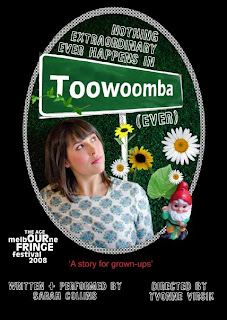Nothing Extraordinary Ever Happens in Toowoomba. (Ever).
Tapped Into Productions
September 27 2008
Festival Hub, Lithuanian Club
I don’t care how many ordinary shows I see during this Fringe, because the extraordinary Nothing Extraordinary Ever Happens in Toowoomba. (Ever) makes up for them all.
Every once in a while you come across a script that makes your heart sing. This is one of those. Sarah Collins has created characters that you can’t help but love, in a world so vivid with detail that it’s hard to believe you didn’t see the Jump Rope for Heart display yourself.
Kevin-John’s conception was part-miracle and home-schooling may not have been the best decision his mother made. Following the incidents with putty and the letter D, Kevin-John is sent to the remedial class at the local school. Not being in the ‘normal’ school also has its challenges, but he meets Wren and is forced to discover his own greatness.
The love Collins has for her characters and her home town shines though the script. It would be so easy to laugh at the likes of Carousel Pony, Maryann and Crazy Nanny, but this writer shows all of their faults, flaws and mistakes without cynicism, so we always laugh with them – and we laugh a lot.
Her writing structure is exquisite. Each character’s journey is complete and all are encircled by the surprising action of Kevin-John’s mother, Julie. Collins tells the story from unexpected and changing points of view, reveals information at exactly the right time, and completes the world with irresistible details like fluffy knickies, Woolies flowers (which cost the price people pay for care when no one else is giving it), and the smell of disinfectant and vegemite.
What is also extraordinary about this work is that it’s a monologue, performed by the writer.
What is even more extraordinary is that it is the first script Sarah Collins has written.
It seems that nearly every time I’m astounded by a new script, Yvonne Virsik is directing it. In the hands of someone less capable, the beauty of Toowoomba could so easily have been misplaced. Virsik brings out the emotional essence a script. She finds empathy and the hidden understanding of the characters, but always lets the audience discover it for themselves.
Collins isn’t an experienced actor, but Virsik ably guides her performance; balancing the humour with poignancy, contrasting the light with the dark, and knowing when to let the script speak for itself and when to let the characters shine.
As if I can’t find enough good about this show, let me also add that the use of props and design is as good as the rest of it. The plastic tiaras, the Noddy egg cup and skipping rope are nostalgic and far more evocative and mysterious than their ordinariness suggests.
I think it’s clear that I liked Nothing Extraordinary Ever Happens in Toowoomba. (Ever). If you want to see a beautiful, authentic story told perfectly – see this show. Or just go because every member of the audience gets a handmade macaroni bracelet. I’m still wearing mine.
This review originally appeared on AussieThearte.com.










